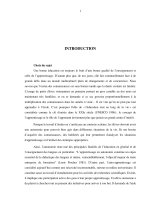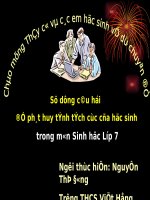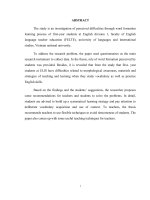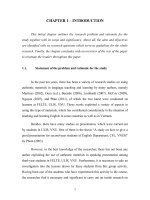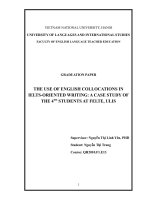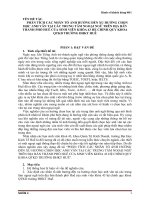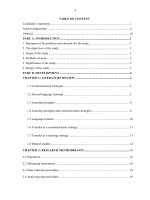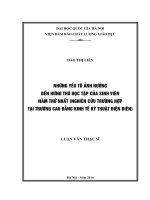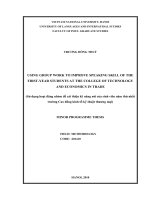KHÓ KHĂN TRONG VIỆC HỌC cấu TẠO từ CỦA SINH VIÊN năm NHẤT KHOA sư PHẠM TIẾNG ANH, TRƯỜNG đại HỌC NGOẠI NGỮ đại HỌC QUỐC GIA HÀ nội
Bạn đang xem bản rút gọn của tài liệu. Xem và tải ngay bản đầy đủ của tài liệu tại đây (449.84 KB, 73 trang )
ABSTRACT
The study is an investigation of perceived difficulties through word formation
learning process of first-year students at English division 1, faculty of English
language teacher education (FELTE), university of languages and international
studies, Vietnam national university.
To address the research problem, the paper used questionnaires as the main
research instrument to collect data. In the thesis, role of word formation perceived by
students was provided. Besides, it is revealed that from the study that first- year
students at ULIS have difficulties related to morphological awareness, materials and
strategies of teaching and learning when they study vocabulary as well as practice
English skills.
Based on the findings and the students’ suggestions, the researcher proposes
some recommendations for teachers and students to solve the problems. In detail,
students are advised to build up a systematical learning strategy and pay attention to
deliberate vocabulary acquisition and use of context. To teachers, the thesis
recommends teachers to use flexible techniques to avoid tiresomeness of students. The
paper also comes up with some useful teaching techniques for teachers.
i
ii
TABLE OF CONTENT
Page
ACKNOWLEDGEMENTS ii
ABSTRACT iii
LIST OF FIGURES viii
LIST OF TABLES ix
LIST OF ABBRREVIATIONS x
CHAPTER 1- INTRODUCTION 1
1.1 Statement of the problem and rationale for the study 1
1.2 Aims and Research questions 2
1.3 Significance of the study 3
1.4 Scope of the study 4
1.5 Organization 4
CHAPTER 2- LITERATURE REVIEW 6
2.1 Basic concepts 6
2.1.1 Definition of word 6
2.1.2 Definition and types of morphemes 7
2.1.2.1 Definition of morphemes 7
2.1.2.2 Types of morphemes 8
2.2 Morphological processes 9
2.2.1 Affixation 9
iii
2.2.1.1 Definition of affixation 9
2.2.1.2 Types of affixation 9
2.2.2 Conversion 10
2.2.2.1 Definition of conversion 10
2.2.2.2 Types of conversion 11
2.2.3 Compounding 13
2.2.3.1 Definition of compounding 13
2.2.3.2 Types of compounding 14
2.2.4 Reduplication 14
2.2.5 Clipping 15
2.2.6 Blends 16
2.2.7 Acronyms 16
2.2.8 Back- formation 17
2.3 Role of word- formation in teaching and learning English 17
2.4 Common EFL learners’ perceived difficulties in morphological
awareness
19
CHAPTER 3- METHODOLOGY 23
3.1 Selection of subjects 23
3.1.1 Setting of study 23
3.1.2 Participants 23
3.2 Data collection instrument 26
iv
3.2.1 Reasons for choosing questionnaires 26
3.2.2 Questionnaire format and content 27
3.3 Procedures of data collection 29
3.4 Procedures of data analysis 30
3.5 Summary 30
CHAPTER 4- FINDINGS AND DISCUSSION 31
4.1 Findings 31
4.1.1 The role of word- formation to first- year students’ learning
process
31
4.1.2 Students’ perceived difficulties in studying word- formation 37
4.2 Implications 45
4.2.1 Implications to first- year students 45
4.2.2 Implications to teachers 48
CHAPTER 5- CONCLUSION 52
5.1 Summary 52
5.2 Limitations 53
5.3 Suggestions for further studies 54
REFERENCES 55
APPENDIX 59
v
LIST OF FIGURES
Figure Page
Figure 1.1: Frequency of practicing word formation in class……………………… 32
Figure 1.2: Frequency of practicing word formation in class (in each skill)…………32
Figure 2: Average time spent on learning vocabulary……………………………… 33
Figure 3: Percentage of time spent on learning word-formation process…………….34
Figure 4: Lexical size……………………………………………………………… 35
Figure 5: Estimated derived words………………………………………………… 35
Figure 6.1: Result of question 6 (Recognition ability to eight word formation
processes)…………………………………………………………………………… 37
Figure 6.2: Result of question 6 (Frequency of choosing right answers)…………….38
Figure 7.1: Result of proficiency test……………………………………………… 39
Figure 7.2: Result of proficiency test……………………………………………… 40
Figure 7.2.1: Affixation………………………………………………………………41
Figure 7.2.2: Compounding………………………………………………………… 41
Figure 7.2.3: Conversion…………………………………………………………… 42
vi
LIST OF TABLES
Table Page
Table 1: ELT program and Double- major program for first-year students at English
Division 1, FELTE, ULIS-VNU…………………………………………………… 25
Table 2: Students’ perceived importance of word formation……………………… 36
Table 3: Material difficulties perceived by first- year students at ULIS………….…43
Table 4: Learning and teaching strategies……………………………………………44
vii
LIST OF ABBREVIATIONS
EFL: English as Foreign Language
ELLs: English Language Learners
ESL: English as a Second Language
FELTE: Faculty of English Language Teacher Education
L2: Second Language
ULIS: University of Languages and International Studies
VNU: Vietnam National University
viii
CHAPTER 1: INTRODUCTION
1.1. Statement of the problem and rationale for the study
Due to the increasingly important role of English in almost every field of our
social life, from communicative uses to business uses, the demand of learning English
has been rising rapidly. In the situation of Vietnam, being aware of English’s role,
most schools and academic institutions have taken English as a compulsory subject.
Consequently, now teaching and learning English are paid much more attention by
both learners and teachers. However, this seems to be far from satisfactory because
foreign learners in general and the Vietnamese learners in particular must face up to
many difficulties in specific fields of English like grammar, pronunciations,
vocabulary, etc.
International linguists state that it is impossible and unaffordable to have a
thoughtful look into human brain to examine how it processes language. Instead,
linguists build hypotheses to verify their appropriate working. One of ways which they
use is grammar. Grammar is considered as a science and often called “science of
language” or “science of how to use words”. According to Domínguez (1991), one of
the biggest goals of linguistic science is “the determination of the rank of morphology
in the grammar of a particular language and in universal grammar”. Then linguists in
the world focus on smaller unit in English and create theories of word-formation.
Word formation is firmly confirmed as the most important divisions in the linguistic
field. However, many EFL learners under-estimate the importance of morphological
awareness as well as word- formation processes. The result of this negative attitude is
slow vocabulary development. According to August et al. (2005) ELLs who
experience slow vocabulary development are less able to comprehend text at grade
level. The situation can become worse when learners may be at risk of being
diagnosed as learning disabled. Learners can fall into the consensus that the reason
1
comes from their poor ability. In fact, it is from their limitation to English vocabulary
and comprehension.
In Vietnam, current grammar and vocabulary teaching is paid more and more
attention, but only about quantity, not quality. It means that students are encouraged to
build up the large numbers of English words, but mostly unsystematically, say, by
learning by heart ,word by word rather than getting to know the derivation of each
word. When learning a new word, for example “nervous”, students only know that
word as a single unit, yet many of them do not know “nervous” is derived from
“nerve”. Thus, this learning style as commented by International linguistic researchers
is unsustainable.
All matters above are strong motivations for the author to choose the topic
“Difficulties of word-formation encountered by first-year students at ULIS” for
the Bachelor’s thesis. The study attempts to investigate problems that first-year
students at ULIS often face up to. From the findings, pedagogical recommendation
will be provided. The author completes this research with the hope that it can become
a useful document for English learners in general and first-year students at ULIS in
particular to partly deal with problems of word-formation.
1.2. Aims and Research questions
First of all, the study attempts to examine the importance of word-formation in
English learning process as perceived by first-year students at ULIS. The biggest aim
of thesis is to figure out the difficulties in word-formation which these students are
often challenged. Personally, this thesis is expectation for teachers and learners at
ULIS to improve the quality of word-formation learning and teaching then raise
students’ morphological awareness. Lastly, with positive results, the author hopes that
the study can give helpful implications to students, teachers and educators as well.
To clarify these initial targets, the paper answers the following questions:
2
1) What is the role of word-formation in English learning as perceived by first-
year students at ULIS?
2) What are the difficulties related to word-formation that first-year students at
ULIS encounter in their learning process?
3) What are implications to first-year students at ULIS to solve their problem in
studying word-formation?
4) What are implications to teachers to help student overcome drawbacks on
learning word-formation?
1.3. Significance of the study
Overall, the research could be considerably a helpful assistance, an available
source for teachers, course administrators and researchers of related topics.
As for teachers at ULIS, the study is conducted with the hope to raise teachers’
awareness in grammar and vocabulary teaching. Once completed, the paper is
expected to give conclusion of the common mistakes of word-formation which
students often make. Based on the findings of the research, several pedagogical
implications will be provided and teachers can adapt them to their teaching and help
learners overcome difficulties in word-formation.
Furthermore, to ULIS students in general and first- year students in particular,
after being aware of possible problems related to word-formation, they will build
carefully learning strategies and have appropriate studying plans. Then, according to
recommendations for students, they can also improve their learning process and adapt
these advices to their plans.
Lastly, this research can be considered as a useful reference for further studies
on the relevant topics. Collected data are able to be a valuable source for educators as
3
well as book editors to make changes with text books in schools and to enhance the
efficiency of vocabulary teaching.
1.4. Scope of the study
Word-formation processes, as defined by Quirk and Greenbeaum in “A
university grammar of English” (2008), consist of eight processes. However, within
the framework of the graduation thesis, this study concentrates on investigating word-
formation which is defined Plag (2002) in the book “Word formation in English”:
“The study of the ways in which new complex words are built on the basis of other
words or morphemes”, or in other words, the thesis mainly focuses on affixation,
compounding, and conversion.
Furthermore, the author specifically aims at investigating problems related to
word-formation process which first-year students at ULIS often encounter. The reason
for the author to choose first- year students as target participants of the thesis is that at
beginning year in university, students must deal with many difficulties belonging to
learning. Most of them find hard to keep up with the higher programs in comparison
with pre- intermediate curricula in high school. The cause of this limitation comes
from many aspects such as unfamiliar skills, lexical awareness, morphological
awareness, etc. However, first- year is the most important time for students to prepare
necessary study skills as well as basic language knowledge for four years at university.
Wishing to help first- year students overcome difficulties of beginning stage, the
author decides to choose one of biggest drawbacks of first-year students; it is- word
formation (belongs to morphological awareness) with the hope that it can partly help
them to be aware of root of obstacles then build up suitable techniques of morphology.
1.5. Organization
This thesis contains five chapters:
4
Chapter 1 (introduction) provides the research’s rationale, aims, significance
and organization.
Chapter 2 (Literature review) presents the theoretical background of the study
which includes discussion of key concepts and related studies.
Chapter 3 (Methodology) describes the research setting, participants,
instruments of data collection and procedures of collecting and analyzing data.
Chapter 4 (Finding and discussion) analyzes collected data and provides
recommendations to students and teachers.
Chapter 5 (Conclusion) summarizes main points of the study and present
limitation as well as some suggestions for further studies.
5
CHAPTER 2: LITERATURE REVIEW
In this chapter, the author will survey theoretical background, studies and
scientific research as well which are related to forming word process. The chapter
consists of four main parts. The first part presents basic concepts which are considered
in terms of definition, types and general features. Concepts are reported here are word
and morpheme. In the second part, the author introduces main types of word formation
– affixation, conversion, compounding as well as other processes which are divided
according to the view of Quirk and Greenbeaum in “A university grammar of English”
(2008). The third being explores the role of word formation in English learning
process. The last part is the focus of the most common difficulties of morphological
awareness perceived by EFL learners.
2.1. Basic concepts
2.1.1. Definition of word
Until now, word is still considered as an abstract matter that receives many
conflicting points of view about its definition from linguistic researchers.
As stated, word is considered in spoken language as the basic unit of the
language which enables effective communication. In other words, word is defined as
an essential instrument for communicative purpose.
As a natural reaction, people tend to think of word as a unit in written system.
For example, orthographic theory in which word is call an orthographic lexicon,
defines word as an interrupted string or letter preceded by blank space and followed by
a blank space or punctuation mark (Plag, 2002)
6
Whereas, Plag (2002) fought the idea of orthographic theory that a word does
not simply depend on fancies of individual writers or the arbitrariness of English
spelling system. He defines word on the basis of four factors: sound structure, internal
integrity, meaning and sentence structure. In accordance with sound structure, Ingo
Plag calls the way that a word built is phonological way. Accordingly, in terms of
phonological method, word is crucial for existence and distribution of stress.
Considering integrity criterion, it is affirmed that word is an indivisible unit into which
no intervening material may be inserted. However, questions about modification of
word are raised and seem to be conflict to the previous idea. As responded by Plag,
when modification element is added to a word, it must be placed at the edge of word.
Although at first stage, internal integrity seems to be a good definition and easily
applied, there are many cases in which internal integrity is violated such as sons – in –
law. This is the reason for Plag to continue with the third criterion – meaning. In other
words, it is the way which a word is defined semantically. In this part, based on
semantic theory, word is pointed out with function of expressing unified semantic
concept. The last criterion is consistent with sentence structure or syntactical structure.
In relation to syntactically-oriented criterion, the word is considered as the smallest
element in sentence and called “syntactic atom”.
In conclusion, from standpoints above, it is obviously not easy at all to decide
whether a string of sounds or a letter is a word or not. It is not too difficult to find
some words that violate what linguists define. However, it is undeniable that four
criteria: sound structure (phonologically), internal integrity, meaning (semantically)
and sentence structure (syntactically) appear to be useful for a sufficient definition of
word.
2.1.2. Definition and types of morpheme
2.1.2.1. Definition of morpheme
7
Contrary to word, morpheme receives similar ideas of how to define from most
linguists. Morpheme is conceived as the smallest linguistic unit with a meaning of
grammatical function. Plag (2002) introduces the definition of morpheme that the
smallest meaningful units decomposed from complex word are morphemes. Sharing
the same point of view, Sorbi (2010) also conceives of morpheme as “the smallest unit
in language to which a meaning may be assigned”. Generalizing similarities of views
above, the author would like to draw a conclusion that morpheme is a minimal unit
which contains meaning of grammatical analysis.
2.1.2.2 Types of morpheme
In most cases, without any confliction, linguists divide morpheme into two
basic kinds. They are free morphemes (or independent morphemes) and bound
morpheme (or dependent morphemes). Zapata (2007) introduces definition of free
morphemes (independent morphemes) that they arise alone as words and have
meaning with a grammatical function, for example, clock, sick, etc. while bound
morphemes (dependent morphemes) occur as part of word. Zapata asserts that these
morphemes can get distinct meanings when they are attached with another morpheme.
Morpheme system can be subdivided into smaller branches in terms of function
and semantic meaning. Firstly, in relation to function, morphemes are subdivided into
derivational morphemes, inflectional morphemes and “cranberry morphemes”.
Morphemes which change lexical meaning of the word belong to derivational
categorization. Morphemes that serve a purely grammatical function and create
different forms of the same words are inflectional morphemes. As for cranberry
morphemes, they are asserted with no constant associated meaning, for example,
permit, commit and submit. Secondly, regarding semantics, there are two types of
morphemes: content morphemes and function morphemes. As the term suggests, they
are linguistic units that hold semantic content with grammatical function while
function morphemes express grammatical relationship between words in sentence.
8
To summarize, studying word-formation has the familiar meaning with dealing
morphologically with complex words (Plag, 2002). In this thesis, the author will
survey and analyze, after all, how “movement” such as adding, removing or changing
position of morphemes can create changes to word.
2.2. Morphological processes
2.2.1. Affixation
2.2.1.1. Definition of affixation
Affixation is the morphological process in which an affix is attached to a root or
stem. In there, roots (or bases) are conceived as the morphemes which hold principal
or basic concepts, ideas or meanings in the word. Roots organizing content and
function word are free morphemes and roots forming part of word are perceived as
bound morphemes. As for stems, they are considered as free roots “to which
derivational affixes have been added or likely to be added” (Zapata, 2007). Thus, it
can be referred that stems sometimes can be roots such fish or place but in some cases,
roots would go with one or more derivations, for example, comfortable,
uncomfortable. In other words, stems are words without inflectional morphemes.
2.2.1.2. Types of affixation
Two authors Quirk and Greenbeaum (2008) divide affixes into two kinds:
prefixes and suffixes. To base on position of affixes, Quirk and Greenbeaum survey
whether they can change meaning and word class or not then come to definition of
each kind of affixation.
With respect to prefixes, it is asserted that they are added to the beginning and
change the meaning of a word. Conversely, suffixes are put to the end of a word and
also can create different meanings for words. While prefixes normally change
9
meanings of words, suffixes can change both meanings and parts of speech. Quirk and
Greenbeaum continuously subdivide prefixes into smaller subsidiary branches:
negative prefixes, preservative (or private) prefixes, pejorative prefixes, prefixes of
degree or size, prefixes of attitude, prefixes of location, prefixes of time and order,
prefixes of number and other prefixes.
In accordance with suffixes, they are subdivided into nine small types:
1. Noun → noun suffixes (e.g., book booklet)
2. Nouns/ adjective → noun/ adjective suffixes (e.g., social socialist)
3. Verb → noun suffixes (e.g., drive driver)
4. Adjective →noun suffix (e.g., sad sadness)
5. Noun/adjective→ verb suffixes (e.g., industrial industrialize)
6. Nouns adjective suffixes (e.g., person personal)
7. Some adjective suffixes common on borrowed and neo-classical words
(e.g., sensitive, criminal)
8. Other adjective suffixes (e.g., changeable)
9. Adverb suffixes (e.g., happily)
2.2.2. Conversion
2.2.2.1. Definition of conversion
It is a common knowledge that affixation is not the only way to create a derived
word but there are various ways to make changes in words, one of them is conversion.
According to Plag (2002), conversion is defined that it is the derivation of a new word
without any overt marking.
10
E.g.: 1. - the bottle to bottle
2. - to call a call
3. - better to better
4. - poor the poor
With the same view, Quirk and Greenbeaum (2008) describe English conversion
as derivational process in which an item changes words-class without an affix. With
definitions of linguists as well as given examples above we can come up with an
appropriate definition for conversion:
It is a process in which a new word is produced not by adding any affix or
changing its form but using this word in new function. Conversion is sometime known
with other names such as functional shift or zero- derivation.
2.2.2.2. Types of conversion
Most linguists recognize two popular branches of this word-formation process:
conversion to noun (from verbs, adjectives, closed-class words, affixes and phrases)
and conversion to verb (from noun and adjectives). Zapata (2007) continues to
subdivide conversion into one more category which is conversion to adjective from
noun.
Eg.: 1. Conversion to noun
• From verbs
answer, attempt, bet, blow-out, bore, catch, cheat, coach, cover, desire, dismay,
etc.
• From adjectives
bitter (type of beer), comic, daily (newspaper), final (race), marrieds (married
people), natural (a naturally skilled player), roast, red, regular (customer), etc.
• From closed-class words
buts, downs, how, ifs, a must, ups, why, etc.
11
• From affixes
Isms (patriotism, capitalism)
• From phrases
also-rans, been-to, do's and don'ts, down-and-out, free-for-all, has-been, high-
ups, know-it-all, low-down, etc.
Eg.: 2. Conversion to verb
• From nouns
baby, bicycle, boat, bottle, brake, butter, canoe, carpet, catalogue, etc.
• From adjectives
calm, calm down, dirty, dry, empty, humble, lower, narrow, sober up, etc.
Eg.: 3. Conversion to adjective from noun
cotton, nylon, reproduction (furniture), wool, Worcester (porcelain), etc.
English conversion process is presented in “A university grammar of English”
by Quirk and Greenbeaum with minor categories: change of secondary word class to
nouns, verbs and adjectives, for example, an uncountable noun converted into a
countable (e.g.: two coffees), an intransitive verb converted into a transitive verb (e.g.:
run), a non gradable adjective converted into gradable adjective, etc.
Besides major and minor classification above, English conversion process is
mentioned with an extra case: sound and stress interchange which is called
“approximate conversion”. In some cases, instead of being converted completely,
conversion is appropriately changed. It can be referred that a word is not only changing
grammatical function, but also following the alteration of pronunciation or spelling.
• Sound interchange
When nouns are converted to verbs, the final unvoiced fricatives /f,θ,s/ will be
pronounced as voiced consonants /v,ð,z/.
E.g.: Noun Verb
12
abuse /-s/ abuse /-z/
belief /-f/ believe /-v/
mouth /θ/ mouth /ð/
When nouns are in the corresponding verb forms, there is a substantial change of
pronunciation especially of vowel sounds.
E.g.: Noun Verb
breath /breθ/ breathe /bri:ð/
bath /bɑ:θ/ or / bæθ/ bathe /beð/
glass /glœs/ (or /glɑ:s/) glaze /gleiz/
• Shift of stress
When two-syllable (or three- syllable) verbs are turned into nouns, the primary
stress is sometimes shifted from the second to the first syllable. The noun and verb
form do not always have the same semantic range (application, uses, meanings or
senses) (Zapata, 2007).
E.g.: decrease (n) /ˈdiːkriːs/ decrease (v) /dɪˈkriːs/
extract (n) /ˈɛkstrakt/ extract (v) /ɪkˈstrakt, ɛk-/
import (n) /ˈɪmpɔːt/ import (v) /ɪmˈpɔːt/
2.2.3. Compounding
2.2.3.1. Definition of compounding
As state by Norquist (2006), in linguistics, the process that two words combine
to make a new word (commonly a noun, verb, or adjective) is called compounding.
Compounds can be in form of one word (teapot), or two hyphenated words (life-
threatening), or two separate words (football stadium). Elements of compounding
13
words can be roots (e.g.: astro-, bio-, photo-, etc.), words (e.g.: park commissioner), or
group of words (e.g.: over- the fence- gossip) (Plag, 2002).
To sum up, until now compounding has been one of the most controversial type
of word-formation in terms of linguistic analysis, the author has desire to slightly draw
a conclusion of compounding:
It is a process combining two or more elements. Each element can be a root, a
word or a phrase. However, we need to note that these elements always belong to two
members: non-head and head.
2.2.3.2. Types of compounding
Forming a compound word is not simply combining two words (or bases)
together. Actually, in English not all words from all word-classes can go with each
other freely. Thus, the invention of compounds always attracts attention of linguists
because it is considered as one of the most productive ways to enrich vocabulary in
every single English dictionary.
Quirk and Greenbeaum (2008) in A university grammar of English divide
compounding words in terms of their part of speech. Thus, there are three main types
of compounds: noun compounds, adjective compounds and verb compounds.
Besides, there are numerous classifying types such as in terms of meaning
(Idiomatic and Non- idiomatic compounds), in terms of structure (Neutral compounds,
Morphological compounds and Syntactic compounds), in terms of componential
relationship (Coordinative and Subordinate compounds) and in terms of the relation of
compound as a whole to its members (Endocentric and Exocentric compound), etc.
2.2.4. Reduplication
Reduplication is a very important process of word formation in most languages
including English but there is a general consensus that reduplicative words in English
14
have been widely ignored. However, many scientific studies indicate that the usage of
reduplication is much more widespread than we expect.
Quirk and Greenbeaum (2008) describe feature of reduplicative words that they
have two or more elements which are either identical or only slightly different. It is
also mentioned that most reduplicative words are highly informal or familiar, and
many of them derive from nursery. The usage of reduplicative is often to imitate
sounds, (e.g., rat-a-tat (knocking on door), tick-tack (of a clock), ha-ha (of laughter),
bow-wow (of dog)), to suggest alternating movement (e.g., see saw, flip-flop, Ping-
Pong), to disparage by suggesting instability, nonsense, insincerity, vacillation, etc.,
(e.g., higgledy-piggledy, hocus-pocus, wishy-washy, dilly-dally, shilly-shally, willy-
nilly) and to intensify (e.g. teeny-weeny, tip-top) (Zapata, 2007, p.7).
Being considered as a special kind of compound, reduplicative words have the
same stress rule as compound. English reduplicative compounds generally have
primary stress on the first constituent, for example, goody- goody, chit-chat, Ping-
Pong, tip-top, etc. However, it is patent that exceptional cases still exist such as pooh-
pooh, harum-scarum, willy- nilly, etc.
2.2.5. Clipping
Clipping refers to process in which lexeme is shortened but still remains the
meaning and part of speech. In clipping process, only style of words changes. Quirk
and Greenbeaum (2008) define clipping that it represents the subtraction of one or
more syllables from word. In the other words, clipping can be seen as a word
shortening process. This shortening can occur at the beginning of the word, the end of
the word (more commonly) and at both ends of the word (rarely).
The domination of clipping is nouns then adjectives, verbs, adverbs (rarely),
preposition, even interjections and conjunctions (more rarely).
15
Zapata (2007) presents other characteristic of clipped forms which is tone of
informality reflected in their spelling such as showbiz (for show business), ‘cause (for
because), etc. Sometimes, to suit the pronunciation of the original word, the spelling of
word is altered, for example, mike for microphone, Mike for Michael, veg for
vegetable, bike for bicycle, etc. However, the tone of informality will usually
disappear when they become well established in the language and acknowledged by
most of community such as taxi, bus, plane, stereo, etc.
2.2.6. Blends
Quirk and Greenbeaum (2008) simplify blends that they have at least one of the
elements which is fragmentary in comparison with its corresponding uncompounded
word. In short, blending is a process in which combining the beginning of one word
and the end of another will create a new word.
E.g.: Bash = bang + smash
Motorcade = motor + cavalcade.
Clash= clack + crash
According to Quirk and Greenbeaum, blends have a short life, are informal and
some of them have become more or less fully accepted in language. However,
blending is obviously one of the most productive ways embraced in English word-
formation process.
2.2.7. Acronyms
In addition, Quirk and Sidney (2008) define acronyms that they are formed
from the initial letters (or lager part) of words. Acronyms are freely produced,
particularly for names of organizations.
According to Quirk (2008), in English, there are two types of acronyms which
are classified based on how acronyms are pronounced. The first type is acronyms
16
which are pronounced as a word, for example, NASA (National Aero- nautics and
Space Administration), UNESCO (= United Nations Educational, Scientific and
Cultural Organization), laser (light amplification by stimulated emission of radiation).
Acronyms of this type are often derived from phrasal names. Many of them belong to
the jargon of particular occupations, organizations or fields of study (e.g.: scientific,
administrative, and political). To people who do not work in, study or familiarize with
these fields, acronyms seem to be completely meaningless. However, some acronyms
occur so frequently that people use them without the slightest idea of what the words
stand for such as laser. The second type is acronyms which are pronounced as
sequences of letters, for example, MIT (Massachusetts Institute of Technology), VIP
(very important person), FBI (Federal Bureau of Investigations), etc. Today, in British
English, there is a trend of writing acronyms without periods between components.
Each constituent letter usually represents a full word or constituent in the compound,
or just a part of a word, as in the following examples, TB (= tuberculosis), TV (=
television), c/o (in care of). Sometimes, some acronyms are given a quasi-phonetic
written form, for example, Emcee for M.C. (= Master of Ceremonies), Deejay for DJ
(= disc jockey), etc. (Zapata, 2007, p.8).
2.2.8. Back- formation
While affixation process forms a word by adding an affix (e.g. kingdom from
‘king’ and ‘dom’, outermost from ‘outer’ and ‘most’, friendship from “friend’ and
‘ship’, etc.), back-formation is essentially reverse. Quirk defines back formation that it
is the process in which new words are produced by removing an affixation from
existing word. In most cases, back formation adapts an existing word with deletion of
a suffix (e.g. edit from editor, enthuse from enthusiasm, execute from execution, etc.).
We can see from examples above, this word- form process generally involves turning
one part of speech to another. For example, to form a verb form a noun, back
17
